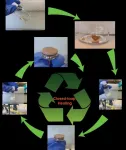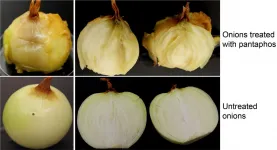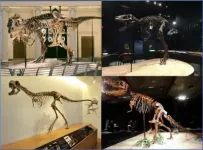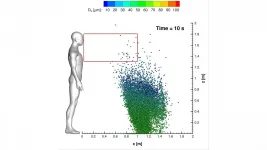Therapy sneaks into hard layer of pancreatic cancer tumor and destroys it from within
In animal models, tumor-penetrating therapy allows chemotherapy drugs to be delivered deeper inside tumor tissue, increasing effectiveness
2021-03-09
(Press-News.org) Every 12 minutes, someone in the United States dies of pancreatic cancer, which is often diagnosed late, spreads rapidly and has a five-year survival rate at approximately 10 percent. Treatment may involve radiation, surgery and chemotherapy, though often the cancer becomes resistant to drugs.
Researchers at University of California San Diego School of Medicine and Moores Cancer Center, in collaboration with Sanford-Burnham-Prebys Medical Discovery Institute and Columbia University, demonstrated that a new tumor-penetrating therapy, tested in animal models, may enhance the effects of chemotherapy, reduce metastasis and increase survival.
The study, published online March 9, 2021 in Nature Communications, showed how a tumor-targeting peptide, called iRGD, can sneak inside the armor that the tumor built to protect itself and use the fibrous tissue as a highway to reach deeper inside, destroying the tumor from within.
The pancreas is a large gland located behind the stomach. It makes enzymes that aid digestion and hormones that regulate blood-sugar levels. Pancreatic ductal adenocarcinoma (PDAC) is a subtype of pancreatic cancer that is highly drug-resistant due, in part, by the hard shell-like outer layer surrounding the tumor.
"This type of tumor is made up of a dense fibrous tissue that acts as a barrier to drugs trying to get through. Many drugs can reach the vessels of the tumor, but they are not able to get deep into the tissue, making treatment less effective, and that is one reason why this type of cancer is so challenging to treat," said Tatiana Hurtado de Mendoza, PhD, first author of the study and assistant project scientist at UC San Diego School of Medicine and Moores Cancer Center.
"Our study found that the tumor-penetrating peptide iRGD is able to use this fibrous network to deliver chemotherapy drugs deep into the tumor and be more effective."
The research team examined the microenvironment of PDAC tumors in a mouse model. They found that after targeting the tumor blood vessels, iRGD binds to high levels of β5 integrin, a protein produced by cells known as carcinoma-associated fibroblasts (CAFs) that produce much of the tumor's protective fibrous cover.
"We were able to closely replicate human disease in our mouse model and found that when iRGD was injected with chemotherapy in mice with high levels of β5 integrin, there was a significant increase in survival and a reduction in the cancer spreading to other organs in the body compared to chemotherapy alone. This could be a powerful treatment strategy to target aggressive pancreatic cancer," said Andrew Lowy, MD, co-corresponding author of the study, professor of surgery at UC San Diego School of Medicine and chief of the Division of Surgical Oncology at Moores Cancer Center at UC San Diego Health.
"What is also exciting about this finding is the iRGD therapy did not produce any additional side effects. This is critically important when considering treatments for patients."
The researchers said next steps include a national human clinical trial. They estimate the trial could begin in one year.
"The knowledge gained from our study has the potential to be directly applied to patient care. We also believe that the levels of β5 integrin within a pancreatic cancer could tell us which patients would benefit the most from iRGD-combination therapy," said Lowy.
INFORMATION:
Co-authors include: Gary Braun, Venkata Kotamraju, Sanford-Burnham-Prebys Medical Discovery Institute; Evangeline Mose and Randall French, UC San Diego Health; Gregory Botta, Sanford-Burnham-Prebys Medical Discovery Institute, UC San Diego Health, Scripps Research Translational Institute; Kodai Suzuki and Norio Miyamura, Columbia University Vagelos College of Physicians and Surgeons ; Tambet Teesalu, Sanford-Burnham-Prebys Medical Discovery Institute, University of California Santa Barbara, and University of Tartu; Erkki Ruoslahti, Sanford-Burnham-Prebys Medical Discovery Institute and University of California Santat Barbara; and Kazuki Sugahara, Sanford-Burnham-Prebys Medical Discovery Institute and Columbia University Vagelos College of Physicians and Surgeons.
[Attachments] See images for this press release:

ELSE PRESS RELEASES FROM THIS DATE:
2021-03-09
Computational models of air quality have long been used to shed light on pollution control efforts in the United States and Europe, but the tools have not found widespread adoption in Latin America. New work from North Carolina State University and Universidad de La Salle demonstrates how these models can be adapted to offer practical insights into air quality challenges in the Americas outside the U.S.
Computational air quality models can be used in multiple ways. For example, they can be used to determine which sources are responsible for what fraction of air pollution. They can also help authorities predict how air pollution might change if different pollution control methods are adopted.
"Historically, it's been very challenging to apply these modeling ...
2021-03-09
Polymer scientists from the University of Groningen and NHL Stenden University of Applied Sciences, both in the Netherlands, have developed a polymer membrane from biobased malic acid. It is a superamphiphilic vitrimer epoxy resin membrane that can be used to separate water and oil. This membrane is fully recyclable. When the pores are blocked by foulants, it can be depolymerized, cleaned and subsequently pressed into a new membrane. A paper describing the creation of this membrane was published in the journal Advanced Materials on 7 March 2021.
How do you clean up an oil spill in ...
2021-03-09
Study Reveals New Hope for Men With Common Urinary Issues
A new systematic review of evidence recommends the use of behavioral self-management treatments for common urinary issues experienced by upwards of 70 percent of older men. Common symptoms include trouble urinating, increased frequency and incontinence. These symptoms can have a substantial negative impact on sleep, social functioning and quality of life. Several guidelines recommend self-management techniques like health education, advice on fluid intake, and bladder retraining; however, in practice, self-management is often excluded from the menu of treatment options that include medication and surgery.
Researchers at Bond University's Institute for Evidence-Based Healthcare found that ...
2021-03-09
What would a truly progressive city look like? A city that pays more than lip service to issues that directly affect low-income residents, seniors, marginalized communities and others whom neoliberal policies have seemingly left behind? ...
2021-03-09
Since 1983, the bacteria Pantoea ananatis has been known to infect several important crops including onions, rice, and corn. It was unclear, however, what molecules were involved. A new study, published in mBio, has identified one of the culprits: pantaphos. Intriguingly, the researchers have discovered that pantaphos can also act as an herbicide and it is toxic to glioblastoma cells, making it an exciting candidate for agricultural and biomedical applications.
"Herbicide resistant weeds are an issue in agriculture," said William Metcalf (MMG leader), a professor of microbiology. "Unfortunately, there hasn't been a new class of herbicide ...
2021-03-09
CHAPEL HILL, NC -- A comprehensive review by University of North Carolina researchers and colleagues of hundreds of publications, incorporating more than two dozen articles on prevention screening for lung cancer with low-dose spiral computed tomography (LDCT), shows there are both benefits and harms from screening. The review is published in JAMA on March 9, 2021.
The results of the decadelong National Lung Screening Trial (NLST) showed that LDCT could detect lung cancer better than conventional X-rays in current or previous heavy smokers. Based on those results, the United States Preventive Services ...
2021-03-09
WASHINGTON, March 9, 2021 -- The University of Minnesota School of Music was concerned about one-on-one teaching during the COVID-19 pandemic and wondered if it should supplement its ventilation system with portable HEPA air purifiers.
So, school officials reached out to Suo Yang, a professor within the College of Science and Engineering, and his team to figure it out. In Physics of Fluids, from AIP Publishing, Yang and the researchers describe their work to predict how virus particles spread within a music classroom.
"The airborne transmission of COVID-19 through ...
2021-03-09
By closely examining the jaw mechanics of juvenile and adult tyrannosaurids, some of the fiercest dinosaurs to inhabit earth, scientists led by the University of Bristol have uncovered differences in how they bit into their prey.
They found that younger tyrannosaurs were incapable of delivering the bone-crunching bite that is often synonymous with the Tyrannosaurus Rex and that adult specimens were far better equipped for tearing out chunks of flesh and bone with their massive, deeply set jaws.
The team also found that tension from the insertion of the lower pterygoid muscle is linked to decreasing stresses near the front of the typical tyrannosaur jaw, where the animals may have applied their highest impact bite ...
2021-03-09
WASHINGTON, March 9, 2021 -- One of the primary ways the COVID-19 virus is transmitted is via airborne diffusion of saliva microdroplets, so it is paramount to find methods to kill the virus in airborne microdroplets.
The extreme confusion that abounded at the beginning of the pandemic about safe social distances, mask wearing, and social behavior inspired Marche Polytechnic University researchers, who happen to be intrigued by saliva droplet diffusion, to search for answers and ways to help.
In Physics of Fluids, from AIP Publishing, Valerio D'Alessandro and colleagues describe using a supercomputer to do numerical modeling ...
2021-03-09
(COLUMBUS, Ohio) - To minimize transmission of COVID-19, in spring 2020, most U.S. states passed policies promoting social distancing through stay-at-home orders prohibiting non-essential travel. Vehicle-miles traveled in the U.S. decreased by 41% in April 2020 compared to 2019. A new study led by researchers at the Center for Injury Research and Policy at Nationwide Children's Hospital estimated associations between COVID-19-related social-distancing policies, traffic volume, and motor vehicle crash-related outcomes in Ohio.
The study, published today in JAMA, found the number of individuals involved in a motor vehicle crash, sustaining injury, sustaining ...
LAST 30 PRESS RELEASES:
[Press-News.org] Therapy sneaks into hard layer of pancreatic cancer tumor and destroys it from within
In animal models, tumor-penetrating therapy allows chemotherapy drugs to be delivered deeper inside tumor tissue, increasing effectiveness







